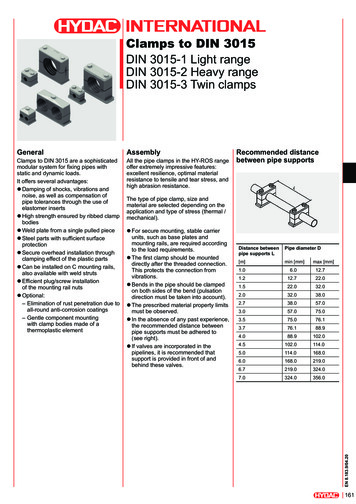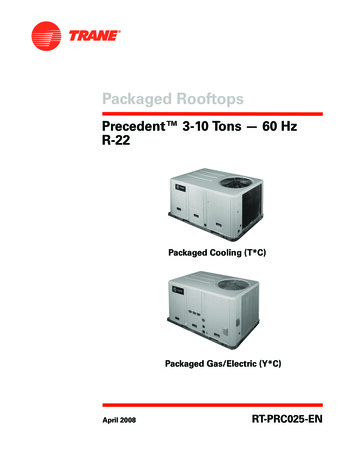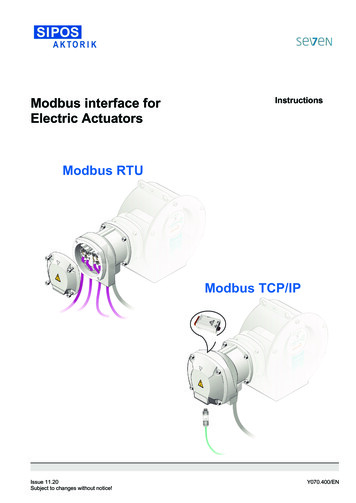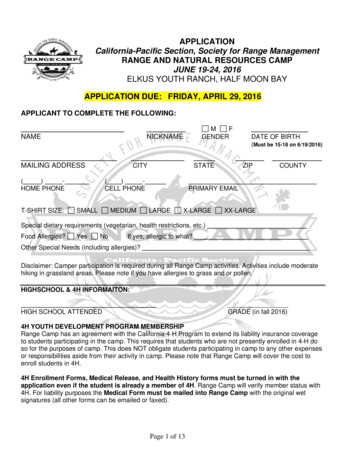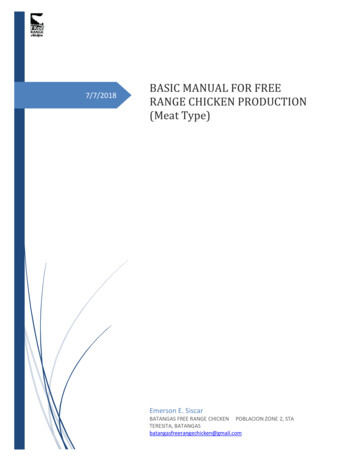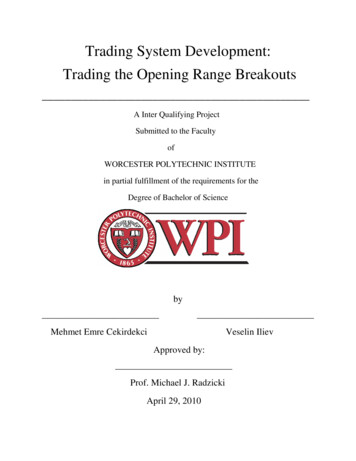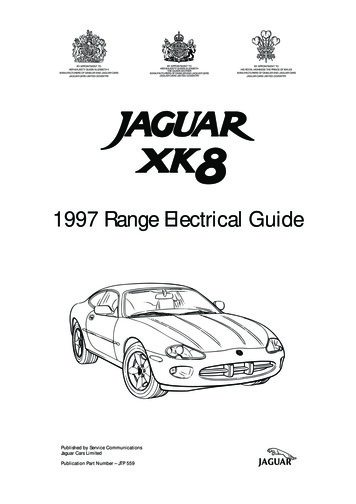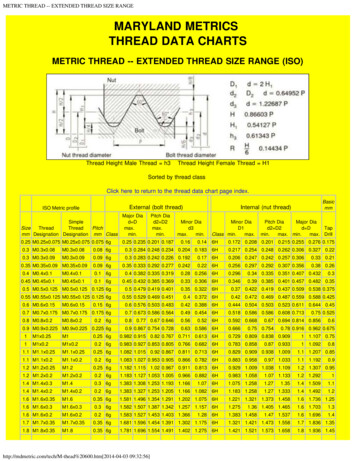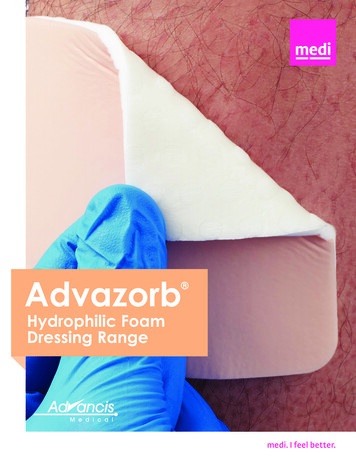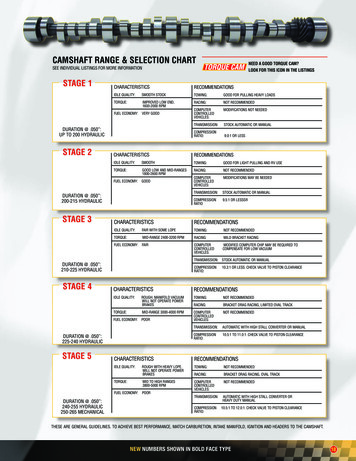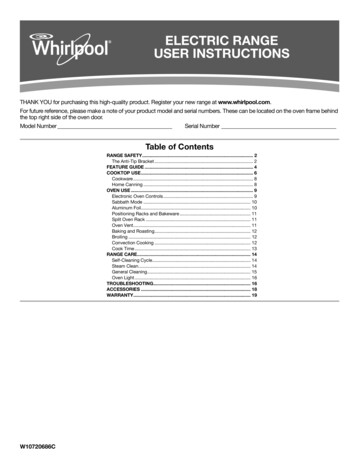
Transcription
ELECTRIC RANGEUSER INSTRUCTIONSTHANK YOU for purchasing this high-quality product. Register your new range at www.whirlpool.com.For future reference, please make a note of your product model and serial numbers. These can be located on the oven frame behindthe top right side of the oven door.Model NumberSerial NumberTable of ContentsRANGE SAFETY. 2The Anti-Tip Bracket . 2FEATURE GUIDE . 4COOKTOP USE. 6Cookware . 8Home Canning . 8OVEN USE . 9Electronic Oven Controls . 9Sabbath Mode . 10Aluminum Foil. 10Positioning Racks and Bakeware . 11Split Oven Rack . 11Oven Vent. 11Baking and Roasting. 12Broiling . 12Convection Cooking . 12Cook Time . 13RANGE CARE. 14Self-Cleaning Cycle. 14Steam Clean. 14General Cleaning. 15Oven Light . 16TROUBLESHOOTING. 16ACCESSORIES . 18WARRANTY. 19W10720686C
RANGE SAFETYYour safety and the safety of others are very important.We have provided many important safety messages in this manual and on your appliance. Always read and obey all safetymessages.This is the safety alert symbol.This symbol alerts you to potential hazards that can kill or hurt you and others.All safety messages will follow the safety alert symbol and either the word “DANGER” or “WARNING.”These words mean:You can be killed or seriously injured if you don't immediatelyfollow instructions.DANGERYou can be killed or seriously injured if you don't followinstructions.WARNINGAll safety messages will tell you what the potential hazard is, tell you how to reduce the chance of injury, and tell you what canhappen if the instructions are not followed.The Anti-Tip BracketThe range will not tip during normal use. However, the range can tip if you apply too much force or weight to the open door without havingthe anti-tip bracket fastened down properly.WARNINGTip Over HazardA child or adult can tip the range and be killed.Verify the anti-tip bracket has been properly installed and engaged per installation instructions.Re-engage anti-tip bracket if range is moved.Do not operate range without anti-tip bracket installed and engaged.Failure to follow these instructions can result in death or serious burns to children and adults.To verify the anti-tip bracket is installed and engaged:Anti-TipBracket Slide range forward. Look for the anti-tip bracket securely attached to floor or wall. Slide range back so rear range foot is under anti-tip bracket.Range Foot See installation instructions for details.State of California Proposition 65 Warnings:WARNING: This product contains one or more chemicals known to the State of California to cause cancer.WARNING: This product contains one or more chemicals known to the State of California to cause birth defects or otherreproductive harm.2
IMPORTANT SAFETY INSTRUCTIONSWARNING: To reduce the risk of fire, electrical shock,injury to persons, or damage when using the range, followbasic precautions, including the following: WARNING: TO REDUCE THE RISK OF TIPPING OFTHE RANGE, THE RANGE MUST BE SECURED BYPROPERLY INSTALLED ANTI-TIP DEVICES. TO CHECKIF THE DEVICES ARE INSTALLED PROPERLY, SLIDERANGE FORWARD, LOOK FOR ANTI-TIP BRACKETSECURELY ATTACHED TO FLOOR OR WALL, ANDSLIDE RANGE BACK SO REAR RANGE FOOT ISUNDER ANTI-TIP BRACKET. CAUTION: Do not store items of interest to children incabinets above a range or on the backguard of a range –children climbing on the range to reach items could beseriously injured. Proper Installation – Be sure the range is properly installedand grounded by a qualified technician. Never Use the Range for Warming or Heating the Room. Do Not Leave Children Alone – Children should not be leftalone or unattended in area where the range is in use.They should never be allowed to sit or stand on any part ofthe range. Wear Proper Apparel – Loose-fitting or hanging garmentsshould never be worn while using the range. User Servicing – Do not repair or replace any part of therange unless specifically recommended in the manual. Allother servicing should be referred to a qualified technician. Storage in or on the Range – Flammable materials shouldnot be stored in an oven or near surface units. Do Not Use Water on Grease Fires – Smother fire or flameor use dry chemical or foam-type extinguisher. Use Only Dry Potholders – Moist or damp potholders onhot surfaces may result in burns from steam. Do not letpotholder touch hot heating elements. Do not use a towelor other bulky cloth. DO NOT TOUCH SURFACE UNITS OR AREAS NEARUNITS – Surface units may be hot even though they aredark in color. Areas near surface units may become hotenough to cause burns. During and after use, do not touch,or let clothing or other flammable materials contact surfaceunits or areas near units until they have had sufficient timeto cool. Among those areas are the cooktop and surfacesfacing the cooktop. Use Proper Pan Size – The range is equipped with one ormore surface units of different size. Select utensils havingflat bottoms large enough to cover the surface unit heatingelement. The use of undersized utensils will expose aportion of the heating element to direct contact and mayresult in ignition of clothing. Proper relationship of utensil toburner will also improve efficiency. Never Leave Surface Units Unattended at High HeatSettings – Boilover causes smoking and greasy spilloversthat may ignite. Make Sure Reflector Pans or Drip Bowls Are in Place –Absence of these pans or bowls during cooking maysubject wiring or components underneath to damage.Protective Liners – Do not use aluminum foil to line surfaceunit drip bowls or oven bottoms, except as suggested inthe manual. Improper installation of these liners may resultin a risk of electric shock, or fire. Glazed Cooking Utensils – Only certain types of glass,glass/ceramic, ceramic, earthenware, or other glazedutensils are suitable for range-top service without breakingdue to the sudden change in temperature. Utensil Handles Should Be Turned Inward and Not ExtendOver Adjacent Surface Units – To reduce the risk of burns,ignition of flammable materials, and spillage due tounintentional contact with the utensil, the handle of autensil should be positioned so that it is turned inward, anddoes not extend over adjacent surface units. Do Not Soak Removable Heating Elements – Heatingelements should never be immersed in water. Do Not Cook on Broken Cooktop – If cooktop shouldbreak, cleaning solutions and spillovers may penetrate thebroken cooktop and create a risk of electric shock. Contacta qualified technician immediately. Clean Cooktop With Caution – If a wet sponge or cloth isused to wipe spills on a hot cooking area, be careful toavoid steam burn. Some cleaners can produce noxiousfumes if applied to a hot surface. Use Care When Opening Door – Let hot air or steamescape before removing or replacing food. Do Not Heat Unopened Food Containers – Build-up ofpressure may cause container to burst and result in injury. Keep Oven Vent Ducts Unobstructed. Placement of Oven Racks – Always place oven racks indesired location while oven is cool. If rack must be movedwhile oven is hot, do not let potholder contact hot heatingelement in oven. DO NOT TOUCH HEATING ELEMENTS OR INTERIORSURFACES OF OVEN – Heating elements may be hot eventhough they are dark in color. Interior surfaces of an ovenbecome hot enough to cause burns. During and after use,do not touch, or let clothing or other flammable materialscontact heating elements or interior surfaces of oven untilthey have had sufficient time to cool. Other surfaces of theappliance may become hot enough to cause burns – amongthese surfaces are oven vent openings and surfaces nearthese openings, oven doors, and windows of oven doors.For self-cleaning ranges – Do Not Clean Door Gasket – The door gasket is essentialfor a good seal. Care should be taken not to rub, damage,or move the gasket. Do Not Use Oven Cleaners – No commercial oven cleaneror oven liner protective coating of any kind should be usedin or around any part of the oven. Clean Only Parts Listed in Manual. Before Self-Cleaning the Oven – Remove broiler pan andother utensils.For units with ventilating hood – Clean Ventilating Hoods Frequently – Grease should notbe allowed to accumulate on hood or filter. When flambeing foods under the hood, turn the fan on. SAVE THESE INSTRUCTIONS3
FEATURE GUIDEThis manual covers several models. Your model may have some or all of the items listed. Refer to this manual or Frequently AskedQuestions (FAQs) section of our website at www.whirlpool.com for more detailed instructions.WARNINGFood Poisoning HazardDo not let food sit in oven more than one hour beforeor after cooking.Doing so can result in food poisoning or sickness.KEYPADFEATUREINSTRUCTIONSClockThis clock can use a 12- or 24-hour cycle. See “Electronic Oven Controls” section.1. Press the Clock keypad.2. Press “3” for AM or “6” for PM.3. Press the number keypads to set the time of day.4. Press START.Oven cavity lightWhile the oven door is closed, press the Oven Light keypad to turn the light on and off. The ovenlight will come on when the oven door is opened.TIMER SET/OFFOven timerThe Timer can be set in hours or minutes up to 9 hours and 59 minutes.1. Press TIMER SET/OFF.2. Press the number keypads to set the length of time in hr-hr-min-min. Leading zeros do nothave to be entered. For example, for 2 minutes, enter “2.”3. Press TIMER SET/OFF or START to begin the countdown. If enabled, end-of-cycle tones willsound at end of countdown.4. Press TIMER SET/OFF twice to cancel the Timer and return to the time of day. Do not pressthe Cancel keypad because the oven will turn off.5. If the Timer is running, but not in the display, press TIMER SET/OFF to display thecountdown for 5 seconds.STARTCooking startThe Start keypad begins any oven function. If Start is not pressed within 30 seconds afterpressing a keypad, the function is canceled and the time of day is displayed.CANCELRange functionThe Cancel keypad stops any oven function except the Clock, Timer and Control Lock.BAKEBaking androasting1. Press BAKE.2. Press the number keypads to set a temperature other than 350 F (175 C) in 5 incrementsbetween 170 F and 550 F (75 C and 288 C).3. Press START.4. To change the temperature, repeat steps 1 and 2. Press START, or wait 5 seconds for thechange to take effect.5. Press CANCEL when finished.4
KEYPADFEATUREINSTRUCTIONSBROILBroiling1. Press BROIL.2. Select the broiling temperature by pressing 1 - high (550 F [288 C]), 2 - medium (500 F[260 C]) or 3 - low (450 F [232 C]). The default setting is high.3. Press START, and then allow the oven to preheat for 5 minutes.4. Position the cookware in the oven, and then leave the door open 6" (15 cm) at the broil stopposition.5. Press CANCEL when finished.TRUECONVECTConvectioncooking1. Press TRUE CONVECT once to select convection baking, twice for convection roasting, or3 times for convection broiling.2. Press the number keypads to set a temperature other than 350 F (177 C) in 5 incrementsbetween 170 F and 550 F (77 C and 288 C).3. Press START. Auto conversion will reduce the temperature by 25 F (15 C).4. To change the temperature, repeat steps 1 and 2. Press START, or wait 5 seconds for thechange to take effect.5. Press CANCEL when finished.KEEP WARMHold warmFood must be at serving temperature before placing it in the warmed oven.1. Press KEEP WARM.2. Set temperature between 145 F and 190 F (63 C and 88 C) using the number keypads. Thedefault temperature is 170 F (75 C).3. Press START.4. Press CANCEL when finished.START TIMEDelayed startThe Start Time keypad is used to enter the starting time for an oven function with a delayedstart. Start Time should not be used for foods such as breads and cakes because they may notbake properly.To set a Timed Cook or a Delayed Timed Cook, see “Cook Time” section.COOK TIMETimed cookingTimed Cooking allows the oven to be set to
Proper Installation – Be sure the range is properly installed and grounded by a qualified technician. Never Use the Range for Warming or Heating the Room. Do Not Leave Children Alone – Children should not be left alone or unattended in area where the range is in use. They should never be allowed to sit or stand on any part of
